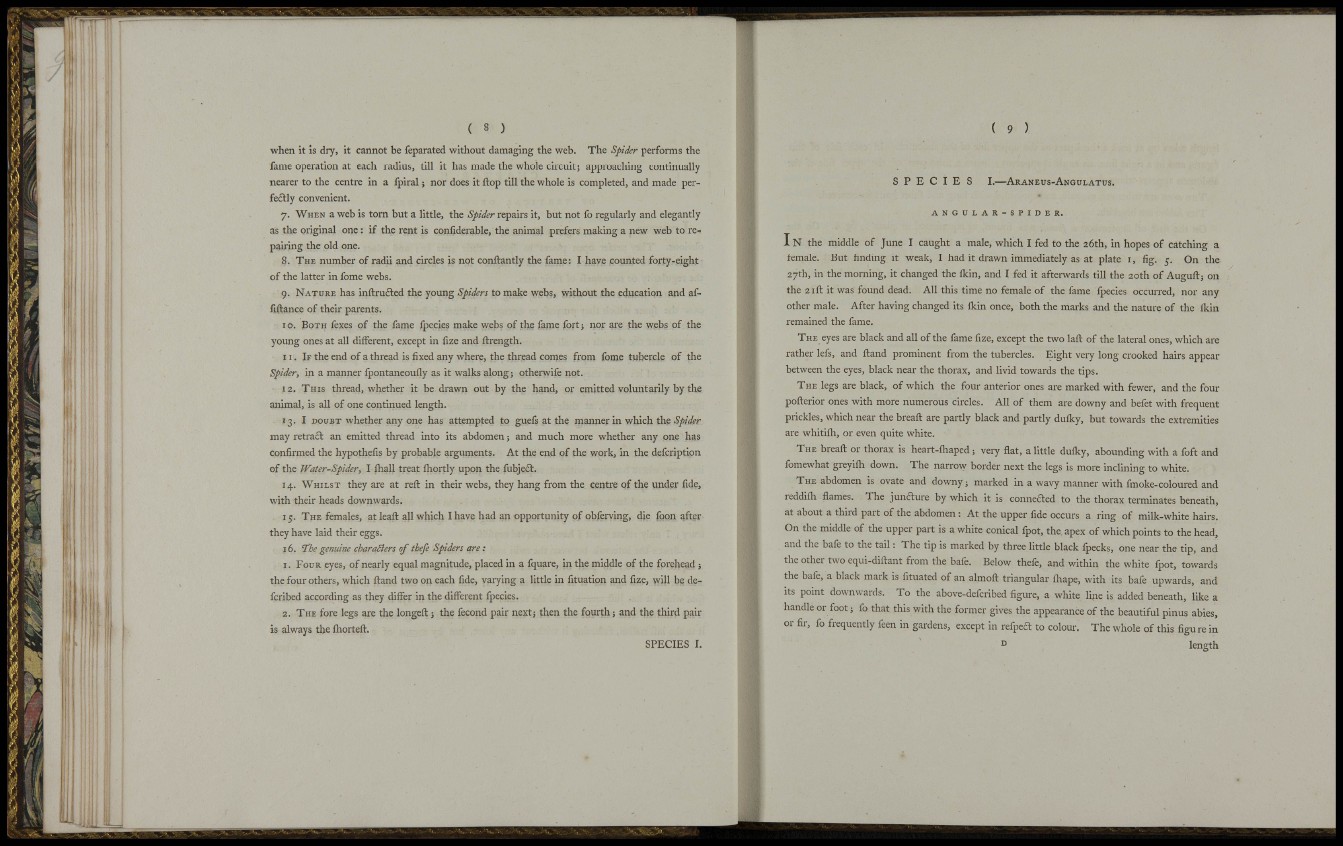
( 8 )
when it is dry, it cannot be feparated without damaging the web. The Spider performs the
fame operation at each radius, till it has made the whole circuit; approaching continually
nearer to the centre in a fpiral ; nor does it flop till the whole is completed, and made perfe£
lly convenient.
7 . WHEN a web is torn but a little, the Spider repairs it, but not fo I'egularly and elegantly
as the original one : if the rent is confiderable, the animal prefers making a new web to repairing
the old one.
8. THE number of radii and circles is not conftantly the fame: I have counted forty-eight
of the latter in fome webs.
9. NATURE has inftrufted the young Spiders to make webs, without the education and afiiftance
of their parents.
1 0 . BOTH fexes of the fame fpecies make webs of the fame fort; nor are the webs of the
young ones at all different, except in fize and ftrength.
11. IF the end of a thread is fixed any where, the thread comes from fome tubercle of the
Spider, in a manner fpontaneoufly as it walks along; otherwife not.
12. THIS thread, whether it be drawn out by the hand, or emitted voluntarily by the
animal, is all of one continued length.
13. I DOUBT whether any one has attempted to guefs at the manner in which the i^zi/ifr
may retraft an emitted thread into its abdomen ; and much more whether any one has
confirmed the hypothefis by probable arguments. At the end of the work, in the defcription
of the Water-Spider, I fhall treat ihortly upon the fubjeft.
1 4 . WHILST they are at reft in their webs, they hang from the centre of the under fide,
with their heads downwards.
15. THE females, atleaft all which I have had an opportunity of obferving, die foon after
they have laid their eggs.
16. T!he genuine charaSiers of thefe Spiders are :
1. FOUR eyes, of nearly equal magnitude, placed in a fquare, in the middle of the forehead ;
the four others, which ftand two on each fide, varying a little in fituation and fize, will be defcribed
according as they differ in the different fpecies.
2. THE fore legs are the longefl J the fécond pair next; then the fourth ; and the third pair
is always the Ihorteft.
S P E C I E S I.
( 9 )
S P E C I E S I.—ARANEUS-ANGULATUS.
A N G U L A R - S P I D E R .
I N the middle of June I caught a male, which I fed to the 26th, in hopes of catching a
female. But finding it weak, I had it drawn immediately as at plate i, fig. 5. On the
27th, in the morning, it changed the fliin, and I fed it afterwards till the 20th of Auguft; on
the 2iil it was found dead. All this time no female of the fame fpecies occurred, nor any
other male. After having changed its Ikin once, both the marks and the nature of the ikin
remained the fame.
THE eyes are black and all of the fame fize, except the two lafl of the lateral ones, which are
rather lefs, and iland prominent from the tubercles. Eight very long crooked hairs appear
between the eyes, black near the thorax, and livid towards the tips.
THE legs are black, of which the four anterior ones are marked with fewer, and the four
pofVerior ones with more numerous circles. All of them are downy and befet with frequent
prickles, which near the breaft are partly black and partly dulky, but towards the extremities
are whitifli, or even quite white.
THE breafl or thorax is heart-fliaped; very flat, a little duiky, abounding with a foft and
fomewhat greyiih down. The narrovy border next the legs is more inclining to white.
THE abdomen is ovate and downy; marked in a wavy manner with fmoke-coloured and
reddifli flames. The junfture by which it is connefted to the thorax terminates beneath,
at about a third part of the abdomen : At the upper fide occurs a ring of milk-white hairs.
On the middle of the upper part is a white conical fpot, the apex of which points to the head,
and the bafe to the tail: The tip is marked by three little black fpecks, one near the tip, and
the other two equi-diftant from the bafe. Below thefe, and within the white fpot, towards
the bafe, a black mark is fituated of an almofl triangular fliape, with its bafe upwards, and
its point downwards. To the above-defcribed figure, a white line is added beneath, like a
handle or foot; fo that this with the former gives the appearance of the beautiful pinus abies,
or fir, fo frequently feen in gardens, except in refped to colour. The whole of this figure in
D length